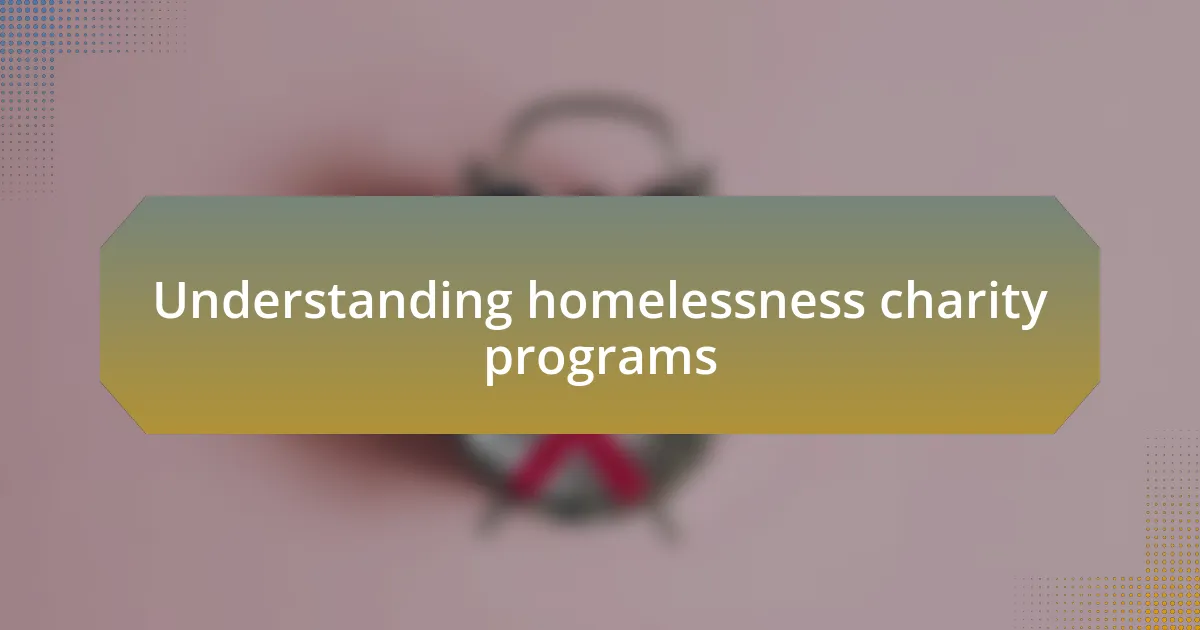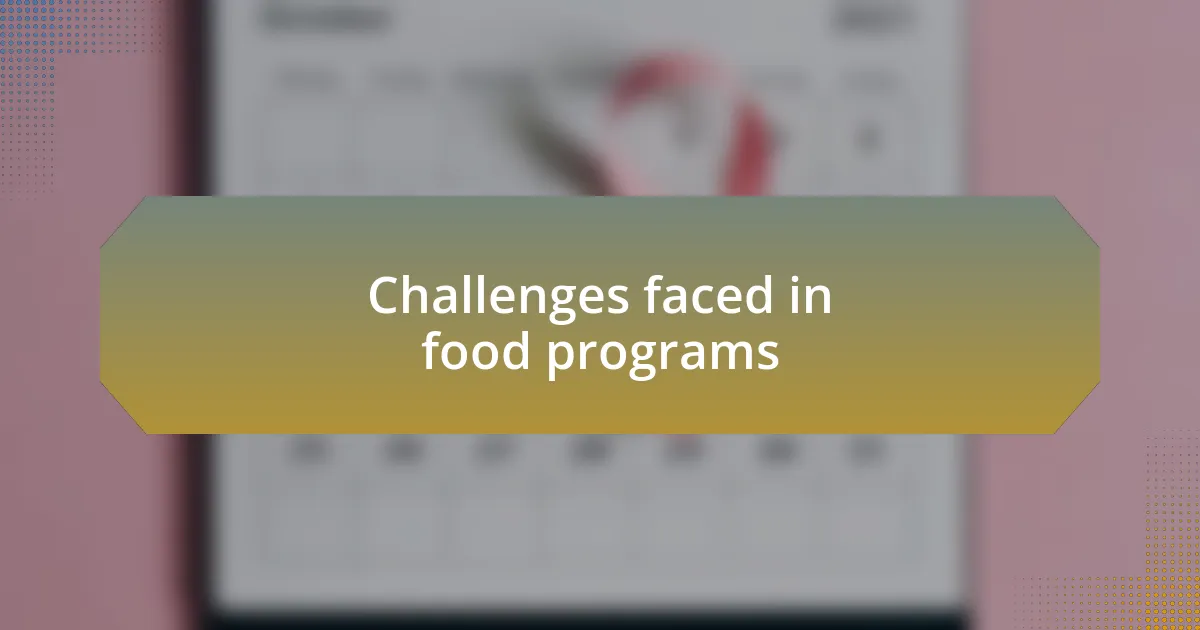Key takeaways:
- Homelessness charity programs play a vital role in addressing both nutritional needs and emotional well-being, fostering community and resilience.
- Access to nutritious food significantly impacts the physical and mental health of homeless individuals, enabling them to focus on rebuilding their lives.
- Organic food programs enhance nutritional access while also providing educational opportunities, empowering individuals to reconnect with cooking and community.
- Challenges such as food waste, inconsistent funding, and logistical issues hinder the effectiveness of food programs, highlighting the need for sustainable solutions.

Understanding homelessness charity programs
Homelessness charity programs often strive to address the multifaceted issues faced by those experiencing homelessness. For instance, I remember volunteering at a local shelter where I witnessed how food assistance was not merely about nourishment; it was a bridge to dignity and stability. This made me wonder, how often do we underestimate the simple act of sharing a meal in fostering a sense of community?
The emotional impact of these programs cannot be overstated. When I saw participants in a housing assistance program celebrate their new homes, joy and hope filled the air. Isn’t it powerful to think that a charity’s effort can transform despair into resilience?
Moreover, many programs also focus on providing skills training, acting as a lifeline for individuals looking to rebuild their lives. I once spoke with a former participant who found his passion for cooking through a charity program. His journey reminded me that sometimes, all it takes is a little support and encouragement to ignite one’s potential.

Importance of nutrition for homeless
Addressing the nutritional needs of homeless individuals is crucial. When I volunteered in a soup kitchen, I saw firsthand how a balanced meal not only satisfied hunger but also contributed to overall health. It struck me that a lack of nutrition often leads to chronic health issues, making it even harder for people to escape the cycle of homelessness.
Additionally, I remember a particular instance where a homeless man shared how vital nutritious food was for his mental well-being. He explained that consuming fresh fruits and vegetables helped him feel a sense of normalcy, reminding him of better days. Isn’t it fascinating how food can have such a profound impact on both physical and mental health?
Moreover, when charity programs prioritize nutritious meals, they are doing more than just feeding people—they are fostering hope and resilience. I encountered individuals who expressed their gratitude for access to healthy food, as it empowered them to focus on their goals. Wouldn’t it be amazing if every community could ensure that everyone had access to the nutrition they need to thrive?

Overview of organic food programs
Organic food programs focus on providing fresh, pesticide-free produce to communities, offering a sustainable approach to addressing nutritional needs. I recall my time working with a local organic farm that set up a community outreach program. It was heartwarming to witness families receiving baskets brimming with vegetables, some of which they had never tried before. How transformative can a simple carrot or a bunch of kale be for someone who has faced food scarcity?
The benefits of these programs extend beyond nutrition; they’re often coupled with educational initiatives that teach individuals how to cook healthy meals. During one workshop, a participant shared her excitement about preparing dishes with fresh ingredients, revealing how cooking had been a lost art for her. Isn’t it incredible how learning to cook with organic produce can bring a sense of empowerment and joy back into someone’s life?
Moreover, organic food programs frequently foster connections within the community, building a support network for those experiencing homelessness. I’ve experienced the warmth of conversations around shared meals, where people from different backgrounds uplifted one another through their stories. Isn’t that what community is all about—finding strength in unity and supporting one another’s journey?

My experience with local charities
I have had the privilege of working alongside several local charities, each with its own unique mission and approach. One particularly memorable experience was volunteering at a food pantry that partnered with organic farms. We sorted through fresh produce, and there was something undeniably uplifting about seeing the faces of the families who came in. Their eyes lit up with hope when they discovered they could take home organic fruits and vegetables—how often do we take that for granted?
My time with these charities has also shown me the power of community engagement. I remember a day when we organized a community meal, inviting everyone to join in. The aroma of healthy dishes filled the air, creating a warm, inviting atmosphere where stories were exchanged over laughter and shared cuisines. Isn’t it fascinating how food can bridge gaps and help us reconnect with our humanity?
Through my interactions with volunteers and beneficiaries, I’ve come to understand that it’s not just about giving—it’s about building relationships. I recall speaking with an elderly gentleman who had been struggling to find stable housing. He told me how receiving a fresh vegetable box felt like someone cared enough to nourish him, not just physically but emotionally. Isn’t that the essence of charity—profound connections that remind us we are never truly alone?

Challenges faced in food programs
One of the most significant challenges I’ve encountered in food programs is the issue of food waste. During one particular volunteer day, I watched in disbelief as we had to sort through a large batch of produce that, while still fresh, didn’t meet the aesthetic standards set by some stores. It was heartbreaking to see so much nutritious food discarded simply because it didn’t have the perfect shape. How often do we overlook the nutritional value of food just because of its appearance?
Another obstacle is securing consistent funding. There were moments when we worried about whether we could continue offering organic options because of fluctuating donations. I remember a tense staff meeting where we discussed scaling back our offerings. That feeling—knowing we might have to tell families they’d receive less than what they needed—was simply gut-wrenching. Does it not raise questions about the sustainability of such vital programs?
Logistical challenges also cannot be ignored. Transporting fresh produce from farms to food pantries often created headaches. On one occasion, I found myself helping load crates into a van, which felt like a race against time to avoid spoilage. The pressure was palpable; we didn’t just want to deliver food; we needed to ensure it was still vibrant and safe for those in need. Isn’t it ironic that the very thing intended to nourish people can become a burden due to logistical hurdles?